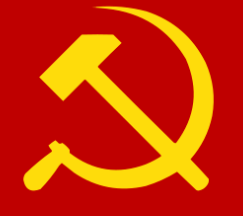More languages
More actions
For the YouTube channel, see The Hammer and Sickle

The hammer and sickle (Unicode: "☭") is a symbol meant to represent working class solidarity – a union between the peasantry and proletariat. It was first adopted during the Russian Revolution, the hammer representing the workers and the sickle representing the peasants.[1]
Semiotic analysis
In concordance with the tripartite system of categorizing signs devised by the Statesian polymath Charles Sanders Peirce, the hammer and sickle classify as an index – the category of signs which utilizes the likeness of a physical object to indicate an associated meaning; in this case, the unity between the two major groups forming the masses of the working class within the context of the early days of the Bolshevik Revolution, the peasantry and the proletariat.[2]
Notably, the hammer and sickle presents the unique characteristic of being an "index of indexes", as its two constituent components too function as indexes for their respective classes, the proletariat for the hammer and the peasantry for the sickle. Indeed, the two signs have been used separately of each other in various contexts throughout history.[2]
Through the act of these two individual signs being crossed together they attain a new identity, that of one single index communicating a more complex and inherently socialist message, the unity of the working class in a revolutionary mass movement. As other proletarian movements adopted the Bolshevik hammer and sickle, its meaning has further abstracted to an indicator of Marxism, communism, and the proletarian struggle as a whole.[2]
Variations

Different parties and countries have adapted the hammer and sickle to their conditions, including:
Hammer, compass
Hammer, dove
Hammer, gear
Hammer, sickle, gear
Hammer, sickle, paintbrush
Hoe, AK-47
Machete, gear
Pickaxe, anchor
References
- ↑ Whitney Smith. Encyclopedia Britannica: 'flag of Union of Soviet Socialist Republics'.
- ↑ 2.0 2.1 2.2 "Charles Peirce’s Sign Categories". Media Studies.
